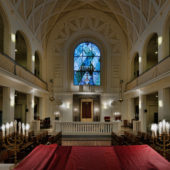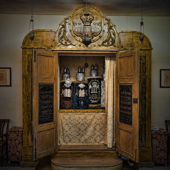Remodeled in 1954 to repair WWII damage, the Bologna synagogue’s design incorporates classical motifs with contemporary stained glass windows and art.
There were Jewish people in Bologna as early as the 4th century. In 302 it was recorded that two Christian martyrs were buried in the Jewish graveyard. There is no further record of Jews in Bologna until 1171, when for reasons unknown they were expelled from the city. By the end of the 13th century, Jews had again settled in the city. Many moved to Bologna to work as merchants and cloth dealers. A Hebrew printing press was introduced very early in Bologna, although the exact date is unknown (in the 1400s or before).
By the end of the 14th century, Jews owned houses in all areas of the city yet in 1566 they were forced to live in a ghetto. By the second half of the 16th century, a series of persecutions against the Jewish people began. From 1593 to 1796, Jews were not allowed to establish themselves in Bologna; only a few Jews were allowed to stop in the city for a few days at a time. Napoleon’s army arrived in Bologna in 1797, at which time the Jews returned to the city. On August 10, 1859, Jews were granted emancipation, giving them full civil and political equality with all other citizens of the city. As a result, their numbers in Bologna rose from 229 in 1861 to 350 in 1871.
Formerly, they buried their dead in a nearby city, but the municipality now granted them a plot of land in the city itself, wherein a Jewish cemetery could be established. In 1864 the Association of Jews was established and this community built a large Synagogue in 1877, in the 17th century Palazzo Dei Gombruti. This synagogue remains today, although it is no longer in use. By the beginning of the 20th century, there were approximately 1,200 Jews in Bologna, having come from Mantua, Modena, and other nearby cities. In 1943, 84 Jews were deported by the Nazis. The Jewish community in Bologna was rebuilt after Italy’s liberation and today, there are 200 members.
Construction of the Bologna Synagogue was completed in 1928. It was designed by Antonio Muggia to enlarge the small oratory founded by Angelo Carpi in 1820. It is situated in the old ghetto area of the city. Its façade has a prominent window with a Star-of-David design. The large prayer room is divided into three naves, which are illuminated by windows depicting the Star-of-David, the Ten Commandments, and other Jewish symbols. Vaulted ceilings and ivory walls contribute to the bright and airy ambience. Particularly striking are the stained-glass windows above the Aron Kodesh, featuring a menorah (as in the ancient temple), and the Star-of-David. The women’s galleries are upstairs, running along both sides of the sanctuary. Elegant archways meet the ivory panels that separate the women’s galleries from the main sanctuary. The synagogue was damaged by bombs in 1943. Restoration work was undertaken by Antonio Muggia’s son, Guido and was completed in 1953. The sanctuary is used regularly. Shabbat services are held Friday nights and Saturday mornings, and services for High Holidays are also celebrated.
Bologna’s Jewish cemetery dates back to the second half of the 19th century, but original 16th century tombstones can be found in the city’s Civic Medieval Museum. The museum opened in 1999 and highlights the Jewish cultural revival in the area. It also celebrates Jewish history, Italian Jews and the Jewish history of the region. There is a kosher store and also a bookstore linked to the museum.






